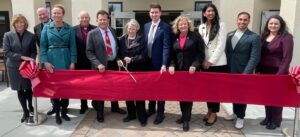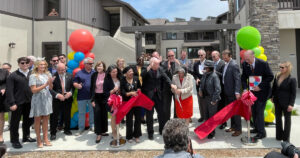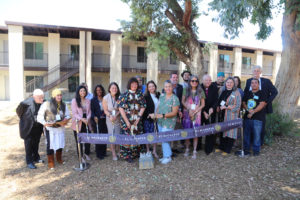
(From left) St. Michael’s Apartments at St. Michael’s Ministry Center, Riverside; Santa Angelina Senior Housing Community at Church of the Blessed Sacrament, Placentia; and Orchard View Gardens, at St. Joseph’s Episcopal Church, Buena Park.
Across California and the nation, the need for affordable housing is both self-evident and invisible, with 80% of L.A. renters who live below the poverty line spending more than half of their income on housing, in addition to the homelessness crisis, according to a 2023 report by the Angeleno Project. In many congregations, the need for new ways to sustainably fund the church mission is also increasingly stark.
Two years ago, Bishop John Harvey Taylor gathered with other diocesan leaders to bless the opening of an affordable housing development on the site of St. Michael’s Episcopal Ministry Center in Riverside. The opening marked a milestone in a bold goal Taylor set for the diocese: to create affordable housing at 25% of church sites.
“Obviously it was an aspirational if not immediately practical goal,” said Taylor, whose successor as bishop of Los Angeles will be elected at the diocese’s convention in November. “Yet I’ll never forget that when the then presiding bishop, Michael Curry, first heard it, at a service for Dr. [Martin Luther] King at Christ the Good Shepherd in Leimert Park, he looked over and said he thought it might be a good idea for a resolution at General Convention. As experts like Michael Bell, members of the Real Estate Task Force, and CFO Susan Stanton will tell you, organizing and financing each of these projects is hard, delicate work. But we’ve been taught to understand that our diocesan real estate is our endowment. The next bishop and their leadership team will have the opportunity to institutionalize this effort in a formal real estate authority of some kind, to do additional affordable housing and other mission appropriate development. We’re doing our best to lay the groundwork.”
Two more affordable housing projects, at Church of the Blessed Sacrament, Placentia, and at St. Joseph’s, Buena Park, have since opened and the developments are serving the community with more than 180 total units of below-market-rate housing. Three more projects in the diocese are in various stages of development, all expected to open within the next five years, on the campuses of St. Anselm, Garden Grove; St. Ambrose, Claremont; and St. Mark’s, Downey.
St. Mary’s in Palms, Los Angeles, has just entered an agreement for feasibility work, to consider how their entire site could be redeveloped to host affordable housing while the congregation continued to operate there, no longer from a typical church building. Numerous other churches in the diocese are in the early stages of exploring the feasibility of affordable housing communities on their campuses.

Ribbon cutting ceremony at the opening of the Orchard View Gardens project at St. Joseph’s, Buena Park.
The Rev. Michael Bell, director of affordable housing development at Episcopal Communities and Services (ECS), which facilitated exploration and negotiation between developers and churches for projects at Blessed Sacrament and St. Joseph’s as well as at St. Ambrose, St. Mark’s, and St. Mary’s, advises congregations in the diocese through the process of affordable housing development.
“Through these affordable housing communities, the diocese will be making a difference in the lives of hundreds of individuals and families across multiple generations who would otherwise be experiencing homelessness or who otherwise would not be able to afford housing in their area,” Bell said. “Bishop Taylor and the congregations should be celebrated for boldly and faithfully trying something that’s not been done before in this diocese, and succeeding.”
However, Bell said that as he’s learned more about developing affordable housing on church sites through these projects, it’s become clear that this type of development, while charitable and mission-aligned, is not necessarily a fix for financial sustainability challenges facing many congregations.
Affordable housing, when it works, he said, is a win-win for churches and the community. The developments can provide sustainable supplemental income without sacrificing focus on mission and community service. However, annual income from developments is not generally enough cover a full-time priest with benefits. “Affordable housing is something to celebrate, and ECS and I will remain focused on this initiative, but there’s also a bigger conversation to be had about leveraging the value of land across the diocese to provide sustenance for ministries well into the future,” Bell said.
Mary Pierson, a member of the diocesan Real Estate Task Force, of which Bell is also a member, as well as the Corporation of the Diocese (COTD), said that the larger conversation is about “highest and best use” of land. She said the idea is “to look at the gifts that we’ve been given and determine what the highest, best use is to further our mission, which is to spread the gospel, to spread the word of Jesus Christ.”
Sometimes this will be affordable housing, Pierson said, but sometimes not. She said it’s especially difficult to create financially-feasible affordable developments on small plots, and that the current political situation, in which the government is potentially looking to limit vouchers for affordable developments, adds uncertainty.
Bell said that while traditional brick-and-mortar church buildings will continue to exist in some places, he would like to see diocesan conversations about new models for collaboratively-funded parochial ministries unburdened from increasing property maintenance overhead costs.
“There’s a lot of property held in trust for the diocese and a lot of value,” Bell said. “How do we leverage that value more strategically toward a way of serving our community more sustainably for the next generations?”
In addition to adapting and evolving ministry, Bell said another vital issue is determining how to prudently manage the proceeds from land sales or long-term leases so that funding streams are perpetual and congregations don’t find their wells dry again within a few years.
“One question is, ‘How do we make use of land to generate income, to keep doing what we’re doing?’,” Bell said. “That doesn’t solve deeper question, like ‘Looking ahead, what are the hungers and needs of this community?’, and ‘How might we adapt our mission and ministry to serve our neighbors into the future, and share the Good News in different ways?’ Which maybe won’t look like trying to get people into pews on a Sunday or asking them to pledge to support the maintenance of a church building.”
The Rev. Susan Stanton, diocesan CFO and Real Estate Task Force member, said that a strategic plan articulating a vision and hopes for a project is a critical step that’s often overlooked. Where an organization currently stands, wants to be, and how it can get there “has to be discussed and agreed upon at the beginning, before you do anything, or else you’re just bouncing off the walls,” Stanton said.
Bell said that when affordable housing won’t provide the income churches need on the timeline they’re looking for, other alternatives like market-rate housing, rental use of property to commercial and non-commercial groups, or even outright sale of portions of church property can generate more income, faster. These strategies can fund the church’s business-as-usual and buy some time, he said, but don’t necessarily mean that fundamental questions are being asked about the needs of the community or adaptive changes needed to thrive into the future.
Bell invoked the “Parable of the Lifesaving Station,” written by Dr. Theodore O. Wedel, a former canon of the Washington National Cathedral. “Read it and wonder, before you get to the very end, ‘when was this written?’,” Bell invited. “We’re still asking the same question: How do we stay the course of the life-saving station and avoid calcifying into an expensive clubhouse?”
Bell, Pierson, and Stanton all agreed that staff focused on mission real estate, beyond the volunteer Real Estate Task Force, would be a good step for managing assets and assisting with development plans and agreements in a comprehensive way. Pierson led the process of applying for a grant to Trinity Church, Wall Street, to fund a position, but the proposal was rejected and the diocese was invited to reapply after the transition between bishops is completed next year.
“We have a wonderful relationship with the folks at Trinity Wall Street, who support a wide range of our ministries,” Taylor said. “I can well understand their discernment in this case, wanting to wait to see what the next bishop and their team will decide. We’ve gone nearly nine years without selling a square inch of sacred property. There are other models and combinations of models. But I believe the Holy Spirit is inviting us not to sell God’s property but to leverage it to support local mission and ministry. If I were an investor looking for the religious expressions that really bring in the attendance dollars, I would put my money in heretical nationalism. We wily Episcopalians, and our progressive conversation partners of all faiths, have to use all the resources God has given us to continue to have a strong, incarnational foundation for proclaiming our countercultural vision of the love and justice of the living God.”
In the meantime, the Real Estate Task Force has worked with a consultant to complete an inventory of more than 350 sacred and non-sacred properties.
The next step, Pierson said, is “a methodology for discerning across the diocese, at the parish level, mission level, etc., whether or not they have the appetite to undertake looking at their gifts of place and determining how they might be better utilized to generate income for their ministry, or better utilized to help them potentially join with another ministry, another local parish.”
Stanton said that before the inventory can be fully utilized, the diocese needs a vision for the future of its land use. “Right now the data is just property information in a spreadsheet,” Stanton said. “Without a strategic plan that really identifies what’s important, what’s not important, what’s on the table, what’s not on the table… and ultimately, what the desired outcome is,” there is no way to determine the best and most efficient use of resources.
Bell suggested that in the future, further centralization of the land management strategy could help congregations navigate the often thorny process, or even leverage combined real estate toward sustainable income streams for mission and ministry in local neighborhoods.
“We would need to address a tension between a shared sense of diocesan operational inter-dependence and more independent parochial interests,” Bell said. “Perhaps moving beyond a mission-share subsidy model to test joint-venture models among parishes, missions, and diocese.”
Bell emphasized he doesn’t have an answer for how the diocese should relate to mission real estate. But he said it’s time the questions are given more attention as centrally important, existential questions for the diocese and for the church in general. Pierson and Bell both added that the Requiem or Renaissance program, now beginning in the Diocese of Los Angeles, is a sign of progress in the right direction: asking hard but meaningful questions about the future. Pierson said it won’t be “Requiem or Renaissance” in all cases, such as for congregations that are not struggling, but that deep discernment about future goals, and work to align asset management with those goals, is essential church-wide.
“The most valuable asset that we have is the property and the people at the congregational level, that’s where our strength is,” Stanton said. “And there’s got to be a collaborative, deliberative conversation that involves a lot of different voices that ultimately will come together, articulate a common vision, develop the strategic plan, and then make sure our resources are aligned with accomplishing what everybody agrees is significant, important for our future. And that’s an exciting process.”


